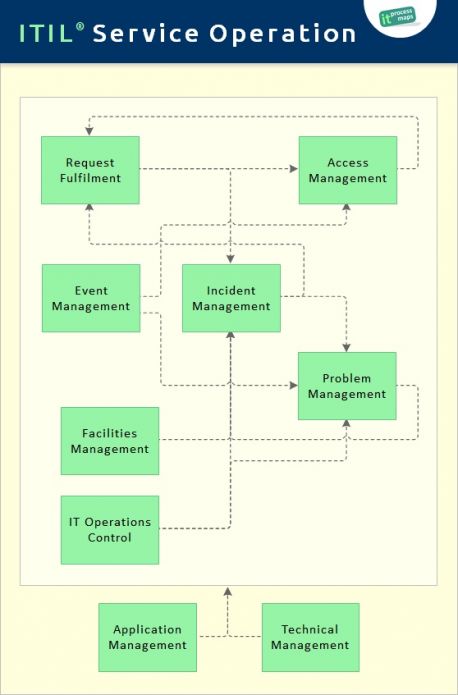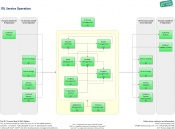ITIL Service Operation: Difference between revisions
No edit summary |
No edit summary |
||
| Line 11: | Line 11: | ||
<br style="clear:both;"/> | <br style="clear:both;"/> | ||
<p> </p> | <p> </p> | ||
'''<span id="ITIL Service Operation definition">Objective:</span>''' <html><span itemprop="description">The objective of <i | '''<span id="ITIL Service Operation definition">Objective:</span>''' <html><span id="md-webpage-description" itemprop="description">The objective of <i>ITIL Service Operation</i> is to make sure that IT services are delivered effectively and efficiently. This includes fulfilling user requests, resolving service failures, fixing problems, as well as carrying out routine operational tasks.</span></p> | ||
<p><b>Part of</b>: <a | <p><b>Part of</b>: <a href="https://wiki.en.it-processmaps.com/index.php/ITIL_Processes#ITIL_Processes_according_to_ITIL_2011" title="ITIL Processes">IT Service Management | ITIL 2011 processes</a></html> | ||
<p> </p> | <p> </p> | ||
| Line 55: | Line 54: | ||
</p> | </p> | ||
<dl><dt><a href="/index.php/Request_Fulfilment" title="Request Fulfilment" itemprop="itemListElement">Request Fulfilment</a> | <dl><dt><a href="/index.php/Request_Fulfilment" title="Request Fulfilment" itemprop="itemListElement">Request Fulfilment</a> | ||
</dt><dd itemprop="description">Process Objective: To fulfill Service Requests, which in most cases are | </dt><dd itemprop="description">Process Objective: To fulfill Service Requests, which in most cases are minor (standard) Changes (e.g. requests to change a password) or requests for information. | ||
</dd></dl> | </dd></dl> | ||
<p><br /> | <p><br /> | ||
| Line 107: | Line 106: | ||
* [https://wiki.en.it-processmaps.com/images/pdf/service-operation-itil-v3.pdf Service Operation (.PDF)]'' | * [https://wiki.en.it-processmaps.com/images/pdf/service-operation-itil-v3.pdf Service Operation (.PDF)]'' | ||
|style="vertical-align:top" | | |style="vertical-align:top" | | ||
[[Image:Service-operation.jpg|thumb|175px|left|none|alt=Service Operation ITIL|The ITIL discipline Service Operation at a glance]] | [[Image:Service-operation.jpg|thumb|175px|left|none|alt=Service Operation ITIL|link=https://wiki.en.it-processmaps.com/index.php/File:Service-operation.jpg|The ITIL discipline Service Operation at a glance]] | ||
|- | |- | ||
|} | |} | ||
| Line 123: | Line 122: | ||
<p> </p> | <p> </p> | ||
== | ==Notes== | ||
<html>By:  Stefan Kempter <a rel="author" href="https://plus.google.com/111925560448291102517/about"><img style="margin:0px 0px 0px 0px;" src="/skins/Vector/images/itpm/bookmarking/gplus.png" width="16" height="16" title="By: Stefan Kempter | Profile on Google+" alt="Author: Stefan Kempter, IT Process Maps GbR" /></a>, IT Process Maps.</p> | |||
< | <p> </p> | ||
</ | |||
<p><small> | <p><small> | ||
| Line 163: | Line 146: | ||
</span> | </span> | ||
</small></p> | </small></p> | ||
</ | |||
<!-- define schema.org/WebPage --> <span itemscope itemtype="https://schema.org/WebPage" itemref="md-webpage-description"> | |||
<meta itemprop="name" content="ITIL Service Operation" /> | |||
<meta itemprop="alternativeHeadline" content="Service Operation" /> | |||
<link itemprop="url" href="https://wiki.en.it-processmaps.com/index.php/ITIL_Service_Operation" /> | |||
<meta itemprop="inLanguage" content="en" /> | |||
<link itemprop="citation" href="https://wiki.de.it-processmaps.com/index.php/ITIL_Service_Operation_-_Servicebetrieb" /> | |||
<link itemprop="citation" href="https://wiki.es.it-processmaps.com/index.php/ITIL_Operaci%C3%B3n_del_Servicio" /> | |||
<meta itemprop="Headline" content="ITIL Service Operation" /> | |||
<link itemprop="isPartOf" href="https://wiki.en.it-processmaps.com/index.php/ITIL_Processes#ITIL_Processes_according_to_ITIL_2011" /> | |||
<link itemprop="primaryImageOfPage" href="https://wiki.en.it-processmaps.com/images/9/96/Service-operation-itil.jpg" /> | |||
<link itemprop="author" href="https://plus.google.com/111925560448291102517/about" /> | |||
<meta itemprop="author" content="Stefan Kempter" /> | |||
<meta itemprop="creator copyrightHolder publisher" content="IT Process Maps" /> | |||
</span><p></html> | |||
<!-- This page is assigned to the following categories: --> | <!-- This page is assigned to the following categories: --> | ||
[[Category:ITIL V3]][[Category:ITIL 2011]][[Category:ITIL stage]][[Category:ITIL process|4]][[Category:Service Operation|!]] | [[Category:ITIL V3]][[Category:ITIL 2011]][[Category:ITIL stage]][[Category:ITIL process|4]][[Category:Service Operation|!]] | ||
<!-- --- --> | <!-- --- --> | ||
Revision as of 11:53, 15 May 2016

Objective: The objective of ITIL Service Operation is to make sure that IT services are delivered effectively and efficiently. This includes fulfilling user requests, resolving service failures, fixing problems, as well as carrying out routine operational tasks.
Part of: IT Service Management | ITIL 2011 processes
Processes: ITIL Service Operation

Service Operation carries out operational tasks.
As per ITIL 2011, the following main processes are part of the ITIL stage Service Operation:
- Event Management
- Process Objective: To make sure CIs and services are constantly monitored, and to filter and categorize Events in order to decide on appropriate actions.
- Incident Management
- Process Objective: To manage the lifecycle of all Incidents. The primary objective of Incident Management is to return the IT service to users as quickly as possible.
- Request Fulfilment
- Process Objective: To fulfill Service Requests, which in most cases are minor (standard) Changes (e.g. requests to change a password) or requests for information.
- Access Management
- Process Objective: To grant authorized users the right to use a service, while preventing access to non-authorized users. The Access Management processes essentially execute policies defined in Information Security Management. Access Management is sometimes also referred to as Rights Management or Identity Management.
- Problem Management
- Process Objective: To manage the lifecycle of all Problems. The primary objectives of Problem Management are to prevent Incidents from happening, and to minimize the impact of incidents that cannot be prevented. Proactive Problem Management analyzes Incident Records, and uses data collected by other IT Service Management processes to identify trends or significant Problems.
- IT Operations Control
- Process Objective: To monitor and control the IT services and their underlying infrastructure. The process IT Operations Control executes day-to-day routine tasks related to the operation of infrastructure components and applications. This includes job scheduling, backup and restore activities, print and output management, and routine maintenance.
- Facilities Management
- Process Objective: To manage the physical environment where the IT infrastructure is located. Facilities Management includes all aspects of managing the physical environment, for example power and cooling, building access management, and environmental monitoring.
- Application Management
- Application Management is responsible for managing applications throughout their lifecycle.
- Technical Management
- Technical Management provides technical expertise and support for the management of the IT infrastructure.
KPIs | Templates | Roles
- KPIs for Service Operation
- Service Operation templates and checklists
- ITIL roles within Service Operation
Downloads
|
Use the following links to open the process overview of Service Operation showing the most important interfaces: |
 |
Demo Service Operation: ITIL Process Map
The ITIL Process Map video shows samples of the ITIL process templates with contents from Service Operation and Incident Management processes, including the
- high-level view of the ITIL Service Lifecycle (Level 0)
- overview of the Service Operation process (Level 1)
- overview of the Incident Management process (Level 2)
- detailed process flow for the process "Incident Resolution by 1st Level Support" (Level 3)
Notes
By: Stefan Kempter ![]() , IT Process Maps.
, IT Process Maps.
Event Management › Incident Mgmt. › Request Fulfilment › Access Mgmt. › Problem Mgmt. › [...]






